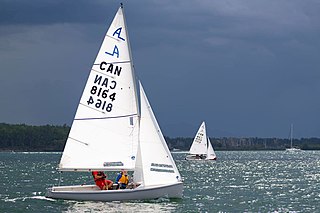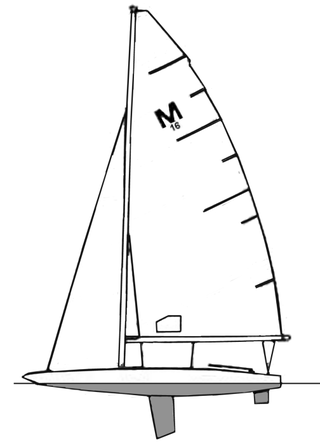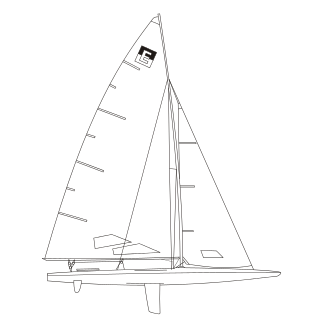
The Tornado is a double handed multihull class recognised as an International Class by the International Sailing Federation. It was used for the Catamaran discipline at the Olympic Games from 1976 to 2008.

The Albacore is a 4.57 m (15 ft) two-person planing dinghy with fractional sloop rig, for competitive racing and lake and near-inshore day sailing. Hulls are made of either wood or fiberglass. The basic shape was developed in 1954 from an Uffa Fox design, the Swordfish. Recent boats retain the same classic dimensions, and use modern materials and modern control systems.

The 470 (Four-Seventy) is a double-handed monohull planing dinghy with a centreboard, Bermuda rig, and centre sheeting. Equipped with a spinnaker, trapeze and a large sail-area-to-weight ratio, it is designed to plane easily, and good teamwork is necessary to sail it well. The name comes from the boat's length of 470 centimetres.

The Flying Dutchman is a Dutch planing sailing dinghy that was designed by Uus Van Essen and Conrad Gülcher as a high performance, one design racer and first built in 1951.

The Firefly is a British sailboat that was designed by Uffa Fox as a one design racer and first built in 1946. The boat was originally named the Sea Swallow. It was an Olympic class and raced at the 1948 Olympics.

The Laser 2, or Laser II, is a sailboat that was designed by New Zealander Frank Bethwaite and Canadian Ian Bruce as a one-design racer and first built in 1978.
One-design racing is a racing method which may be adopted in sports using complex equipment, whereby all vehicles have identical or very similar designs or models, avoiding the need for a handicap system.

The Laser Pico dinghy is a small sailboat designed by Jo Richards in the mid-1990s and used primarily for training and day sailing. It can be crewed by one or two children or an adult. Current models come equipped with both a mainsail and a jib, the jib however mainly functions as a training tool and provides little to no contribution to speed. The Pico functions mainly as a training boat for younger children because of its very durable nature and has little to no racing events dedicated to it.

The Fireball is a British sailing dinghy that was designed by Peter Milne as a one-design racer and first built in 1962.

The Snipe is an American sailing dinghy that was designed by William F. Crosby as a one design racer and first built in 1931.

The International 14 is an International racing sailboat, crewed by two sailors. The class was established in 1928.

The Laser Stratos is an all-round cruising and racing boat designed by Phil Morrison and built by LaserPerformance, the same company as the famous Laser Standard dinghy. It is built from fibre-glass and foam sandwich. The Laser Stratos comes in two forms, one with a keel and one with a centreboard. The centreboard version is red and the keel version is blue. The Stratos is quite spacious and most of the rigging is kept out of the way. The boat can optionally be fitted with trapeze lines and an engine bracket for carrying an outboard engine.

The RS300 is a modern racing sailing dinghy made by RS Sailing. The RS300 is a one-design, single-handed, hiking dinghy with a PY of 972. Designed by Clive Everest and first produced in 1998, it is inspired by the International Moth, of which Everest was a successful designer.

The M Scow, also called the M-Scow and the M-16 Scow, is a Canadian/American sailing dinghy that was designed by Johnson Boat Works and Melges Boat Works as a one-design racer and first built in 1950.

The E Scow is an American sailing dinghy that was designed by Arnold Meyer Sr as a one-design racer and first built in 1924.
The Pacer class of sailing dinghy, formerly known as the Puffin Pacer, was designed in the United Kingdom by Jack Holt. It was commissioned by Puffin Paints and Glues to be designed as sailing dinghy for use by families, so needing to be larger than their earlier Puffin dinghy. It has since become a popular learning and racing dinghy in Australia, Canada, the Netherlands, India and the UK. The name was changed in the UK early 1970s, although Australia continued to use the name until 1989, when they followed the UK in dropping the "puffin" and chose the wedge-tailed shearwater as the boat's symbol.
The RS Vareo is a modern, single-handed sailing dinghy raced throughout the UK at both club and national level. The RS Vareo is a hiking singlehander with an asymmetric spinnaker.

The B14 is a two person monohull dinghy, designed by Julian Bethwaite. It is recognised as an international class by the International Sailing Federation. The boat was designed in 1984.

The Hobie Tiger or Hobie Tiger 18, is a French catamaran sailboat that was designed by Hobie Cat Europe as a Formula 18 racer and first built in 1995.
Handicap forms for sailing vessels in sailing races have varied throughout history, and they also vary by country, and by sailing organisation. Sailing handicap standards exist internationally, nationally, and within individual sailing clubs.